Research Paper - (2011) Volume 19, Issue 6
Department of Family Medicine, Mayo Clinic, Rochester, MN, USA
Kurt B Angstman MD MS
Department of Family Medicine, Mayo Clinic, Rochester, MN, USA
Priscilla M Flynn DrPH
Office of Women’s Health, Mayo Clinic, Rochester, MN, USA
Jessica R Schmitt MEd
Office of Women’s Health Clinic, Mayo Clinic, Rochester, MN, USA
Amy L Weaver MS
Division of Biomedical Statistics and Informatics, Mayo Clinic, Rochester, MN, USA
Lynne T Shuster MD
Division of General Internal Medicine and Women’s Health Clinic, Mayo Clinic, Rochester, MN, USA
Received date: 18 April 2011; Accepted date: 29 September 2011
Background The Papanicolaou (Pap) test is an effective, well-accepted screening tool that has led to a decrease in cervical cancer incidence and mortality. Updated evidence-based cervical cancer screening guidelines support less frequent testing in low-risk patients but have met resistance from providers and patients. AimsTo assess patient knowledge about cervical cancer screening and attitudes toward recommendations for less frequent testing. MethodsA hard copy of an eight-question survey was distributed to 389 women aged 30–64 years at two primary care clinics in Rochester, Minnesota, over a six-week period. ResultsThe survey response rate was 86.8%.Of the 280 women who responded to a survey question about the cause of cervical cancer, 212 (75.7%) identified human papillomavirus (HPV) as the cause. Multivariable logistic regression analysis showed that this knowledge was not associated with feeling comfortable with a recommendation for less frequent testing or with support for less frequent testing. The only significant predictor of patient comfort and adherence with a two- to three-year Pap testing interval was the patient’s belief about whether a Pap test was needed annually or every two or three years. Conclusions Patient belief about Pap testing frequency was the strongest predictor of attitude toward less frequent Pap testing and was not based on knowledge of HPV. Future studies should explore why some patients continue to expect annual testing and identify interventions to help providers elicit and change patients’ expectations about cervical cancer screening.
cervical cancer, patient expectations, screening
The Papanicolaou (Pap) test is an effective screening tool that has led to a decrease in cervical cancer incidence and mortality.[1] Although there are some discrepancies between the current guidelines from the American Cancer Society (ACS), the US Preven-tive Services Task Force (USPSTF) and the American College of Obstetricians and Gynecologists (ACOG), there is a consensus that Pap tests are not needed more often than every two to three years for routine screening among low-risk women.[2–4] These guidelines are based on clinical trials showing minimal differ-ences in the cumulative reduction of cervical cancer in comparisons of one-, two- and three-year Pap test intervals[5] and an understanding of the transient nature of most human papillomavirus (HPV) infec-tions.[6]
Acceptance of Pap testing is high in the USA, and expectations for annual testing are so deep-seated that many patients resist less frequent screening inter-vals.[7–9] Over-testing increases the potential for false-positive results, which may lead to further unnecessary evaluations, increased costs and increased anxiety. Despite the potential for these negative outcomes, the public is enthusiastic about annual cancer screening.[10]
As part of a broader quality improvement project addressing adherence to cervical cancer screening guidelines at our medical institution, we sought to explore patient knowledge, understanding and atti-tudes toward cervical cancer screening. Specifically, we formulated two aims: (1) assess patient knowledge about Pap tests and cervical cancer; and (2) assess patient comfort level with a provider’s recommen-dation for less frequent Pap testing and the likelihood of adherence to that recommendation.
Survey instrument and sampling frame
Our survey was created to test the following assump-tions:
• The majority of patients surveyed would not know about appropriate screening intervals or the cause of cervical cancer (HPV).
fla history of a prior abnormal Pap test would be associated with a higher likelihood of knowing that HPV causes cervical cancer.
flage would be inversely associated with knowledge levels about HPV (i.e. younger patients would have more knowledge).
• Knowledge of HPV as the cause of cervical cancer would predict increased comfort with and greater likelihood of following recommendations for less frequent testing.
Design of the patient survey was informed by several published surveys on HPV knowledge and was piloted among women similar to those in the study popula-tion.[11–13]. The survey contained eight closed questions (Table 1). Approval was sought to distribute 400 surveys, with a target of 250 completed surveys for analysis.
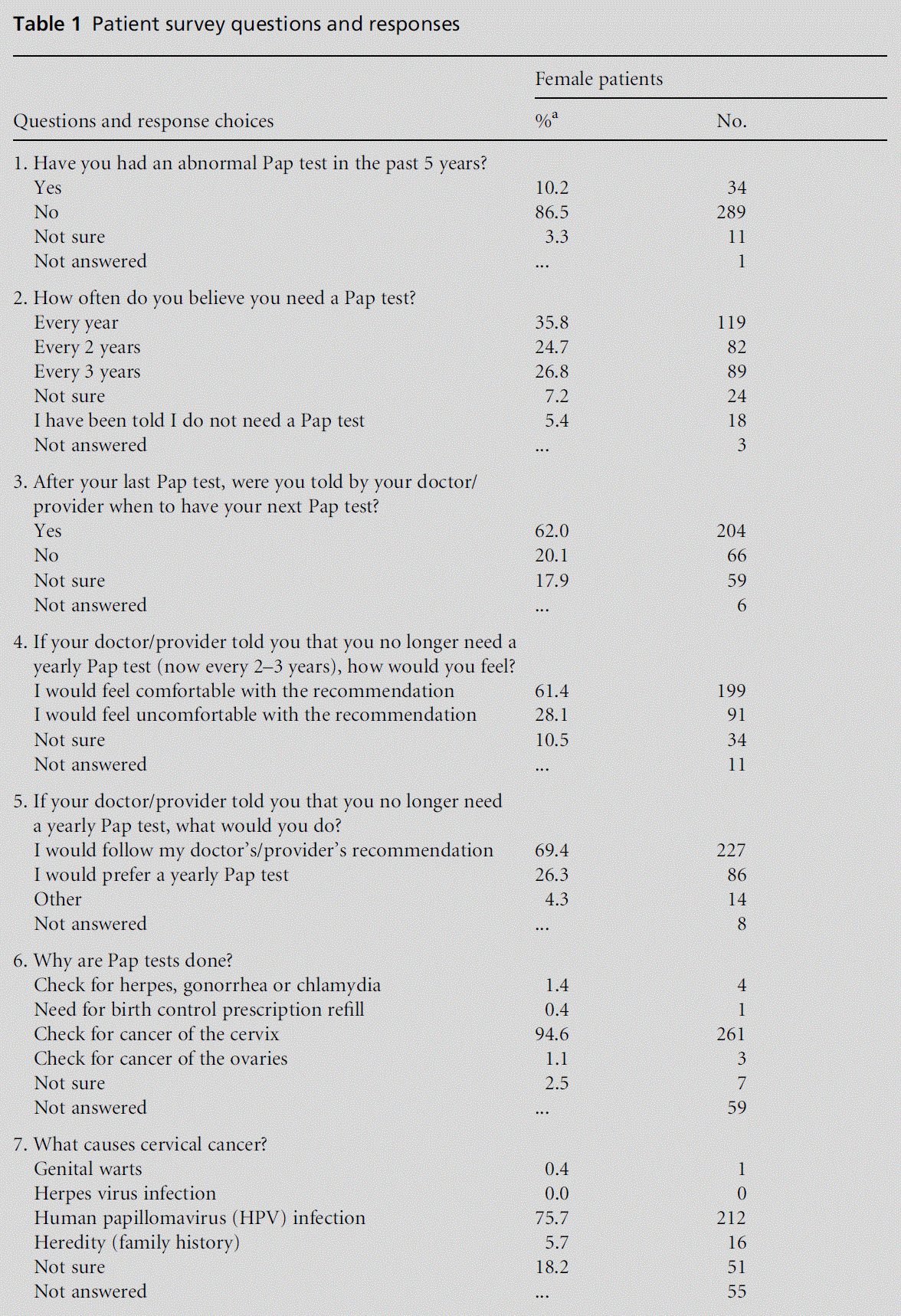
The Mayo Clinic Institutional Review Board ap-proved this study. A paper survey was distributed by clinical desk staff personnel to women aged 30–64 years at Mayo Family Clinic Northeast and Mayo Family Clinic Northwest in Rochester, Minnesota, during a six-week period in November and December 2007. Together, the clinics serve 41 000 patients cared for by 31 physicians in family medicine, internal medicine and paediatrics, and by six mid-level providers. The patients seen in these practices are generally insured and have adequate access to health care and preventive services. Approximately 50% are Mayo Clinic em-ployees or their dependents. Qualifying women were offered the survey regardless of the reason for their appointment. The age range of 30–64 years was chosen to reflect the age group of greatest consensus among the cervical cancer screening guidelines (ACS, ACOG and USPSTF).
Statistical analysis
For each of the eight survey questions, response per-centages were based on the number of women who answered the questions. Comparisons were assessed using the [2] test. Multivariable logistic regression analysis was used to assess the association between various factors with (1) how comfortable a patient was with changing Pap testing recommendations, and
(2) how likely she was to follow those recommen-dations. Associations were summarised by calculating odds ratios and corresponding 95% confidence intervals (CIs). All P-values were two-tailed, and P-values < 0.05 were considered statistically significant. Stat-istical analyses were performed using the SAS version 9.2 (SAS Institute Inc, Cary, NC, USA).
Of the 389 surveys distributed, three were discarded because the respondent was younger than 30 or older than 64, and 51 were returned blank (response rate, 86.8%). A total of 335 surveys were analysed, including 95 surveys with at least one missing response. Re-sponses are summarised in Table 1.
Patients were stratified into two groups according to their reported knowledge of the cause of cervical cancer. Of the 280 women who responded to the question about the cause of cervical cancer, 212 (75.7%) identified HPV as the cause. The remaining 123 responses, n = 17 answered incorrectly, n = 51 not sure and n = 55 did not answer the question, were grouped together for subsequent analysis. Patient age and history of a prior abnormal Pap test in the past five years were not significantly different between the groups (Table 2). Among women who believed that they needed to have future Pap testing, responses were similar between women who knew that HPV causes cervical cancer and those who did not when asked how often they thought they should be tested (P = 0.067), whether they would be comfortable with a recommen-dation to change the frequency of Pap testing to every two to three years (P = 0.31), and whether they would follow their provider’s recommendation of no longer needing a yearly Pap test (P = 0.32).
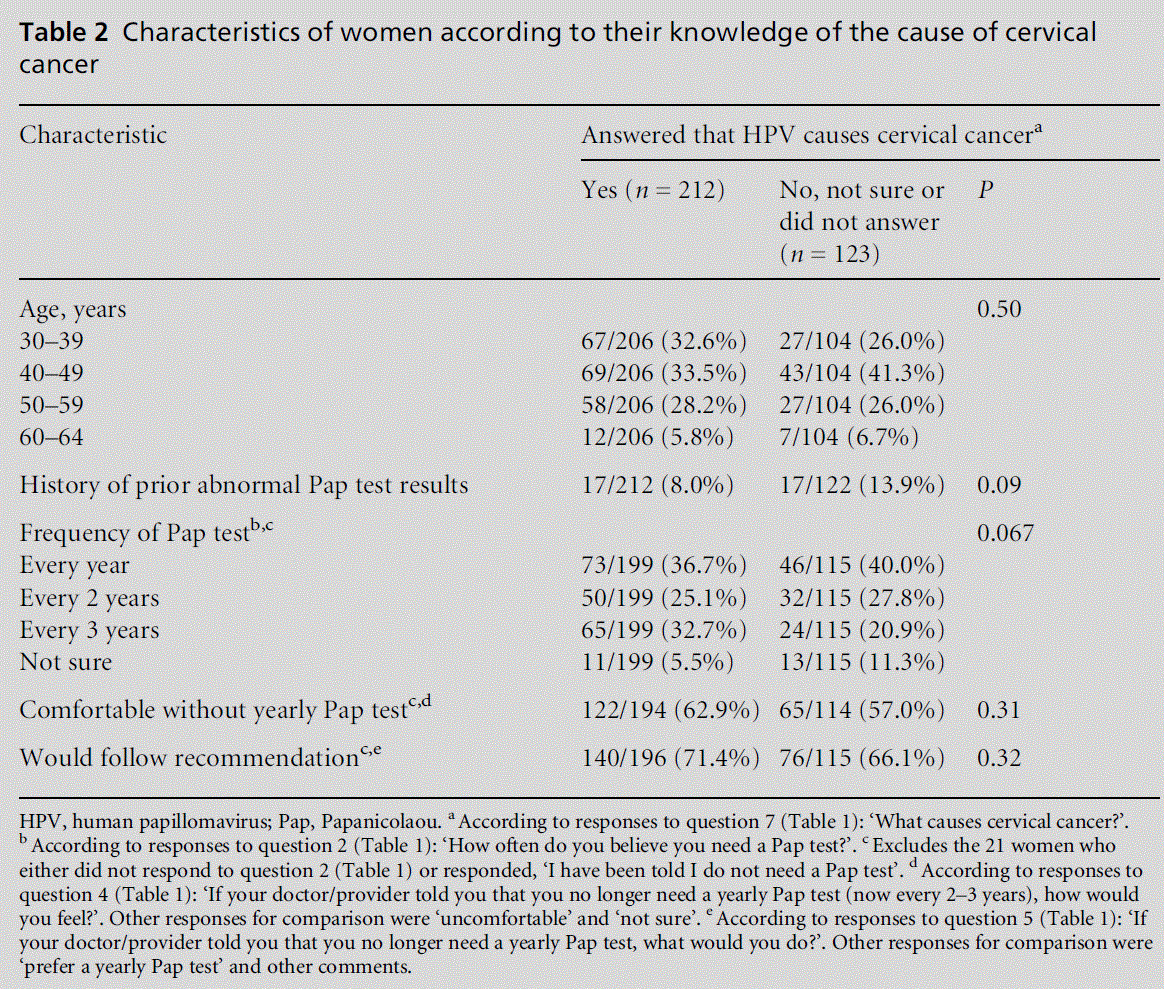
Responses from the subset of women who believed that they needed to have future Pap testing and reported having no abnormal Pap test results in the past five years were evaluated further. Among those who cor-rectly answered that HPV was the cause of cervical cancer, those who felt that Pap testing should be done annually were significantly less likely to be comfort-able with a change in frequency and significantly less likely to follow their provider’s advice than those who felt that testing could be done every two or three years (P < 0.001 for both questions). Similar associations were observed among patients who were incorrect about or unsure of the cause of cervical cancer or did not answer the question (P < 0.001 for both questions; Table 3). Irrespective of their understanding of the cause of cervical cancer, women who felt that Pap testing should be done annually, compared with women who felt that testing could be done every two or three years, were significantly less likely to be com-fortable with a change in recommendations (29.6% vs 80.8%, P < 0.001) and significantly less likely to report a willingness to follow the provider’s advice (40.5% vs 86.1%, P < 0.001).
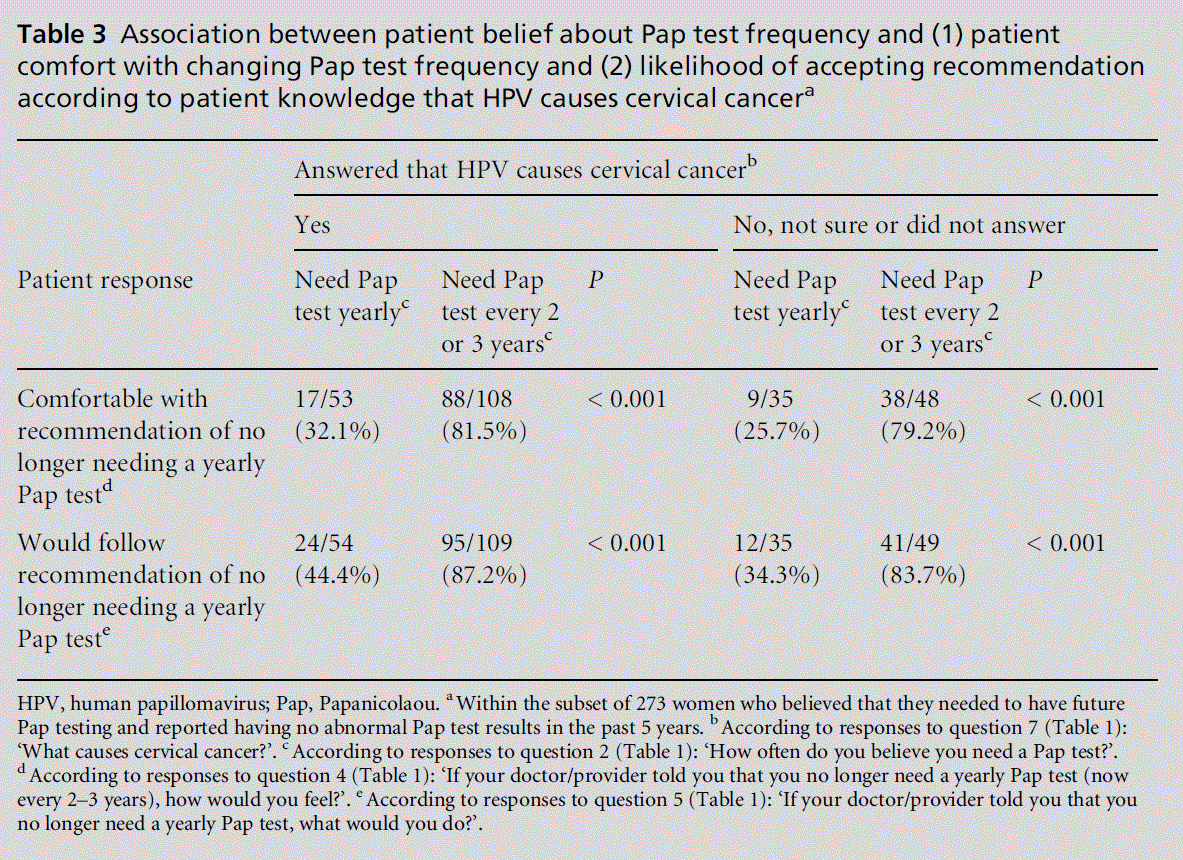
Tables 4 and 5 summarise the results of the multi-variable logistic regression analysis for the women who believed that they needed future Pap testing regarding whether they would be comfortable with a change in screening frequency recommendations and whether they would follow a provider’s advice. With analyses controlling for age, history of abnormal Pap testing, and knowledge of the cause of cervical cancer, patients who believed that they needed Pap testing every two or three years were 8.4 times (95% CI, 4.69– 15.14) more likely to report being comfortable with a change in recommendations compared with patients who believed that they needed Pap testing yearly. Likewise, patients who believed that they needed Pap testing every two or three years were 10.8 times (95% CI, 5.68–20.63) more likely to report that they would follow their provider’s recommendation of no longer needing a yearly Pap test.
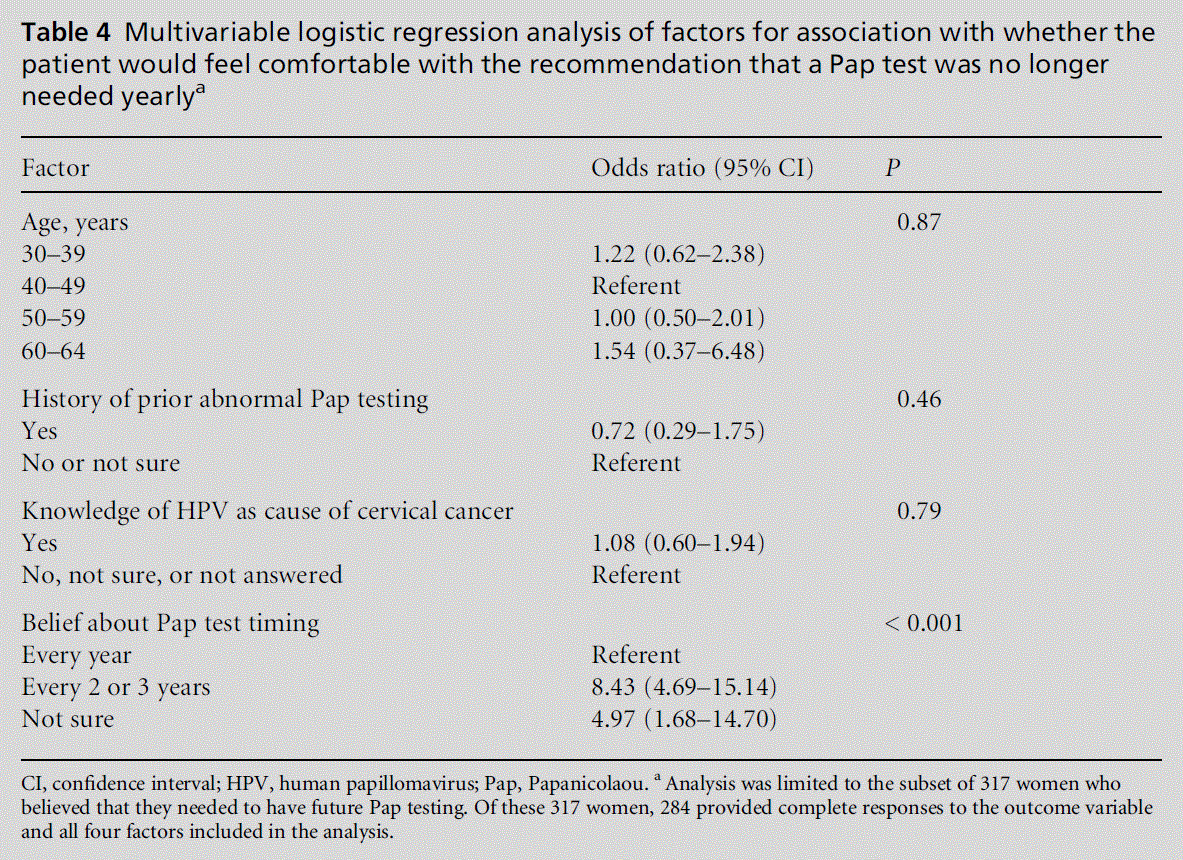
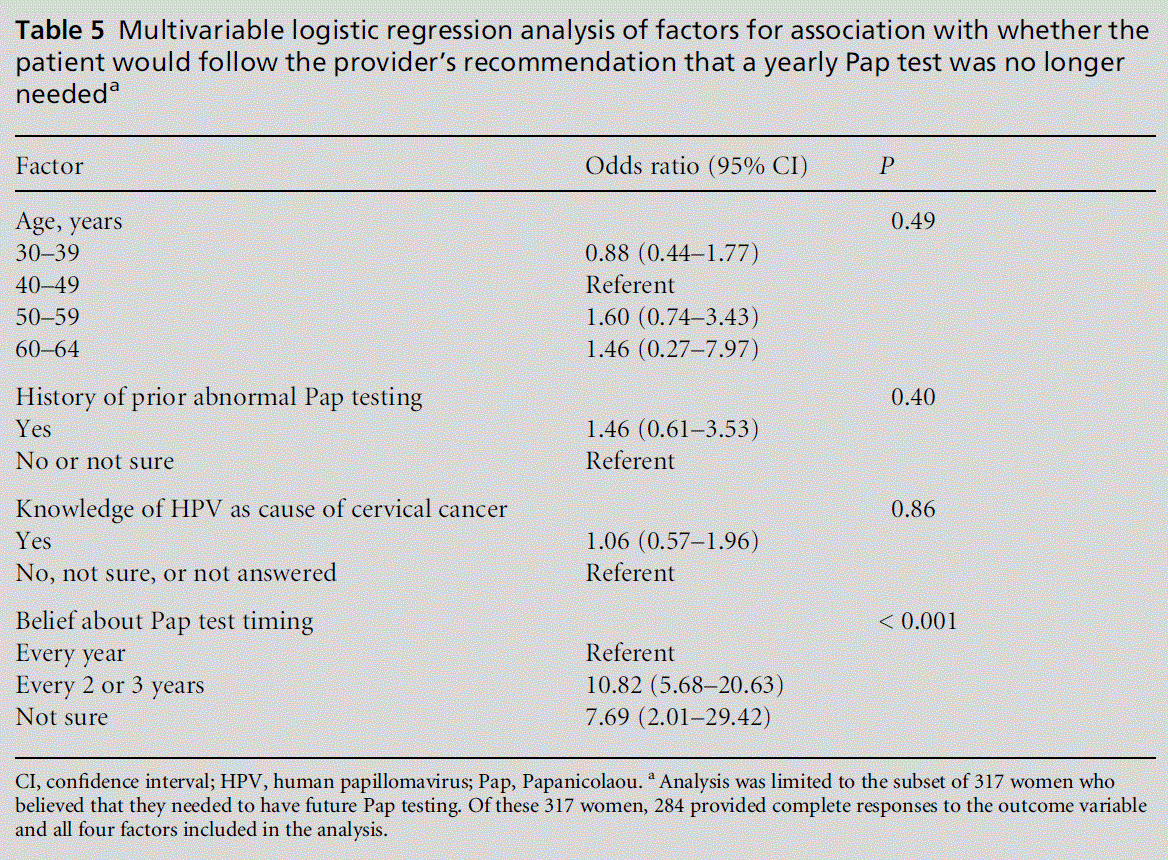
Past studies of patients’ attitudes toward Pap screening frequency have noted resistance to decreasing intervals for Pap testing.[9,14,15] When Rolnick et al[14] surveyed women in a health maintenance organisation and asked their opinion about a three-year interval for screening Pap tests, only 14% responded in support of a three-year interval, 16% were neutral, 20% were sceptical and 50% had a negative response. Sirovich et al[9] reviewed a 2002 survey involving 360 women: 75% reported preferring annual screening and 69% reported that they would continue to request annual screening even if their physicians advised a decreased frequency. Smith et al[15] explored patient attitudes about risk-based cervical cancer screening through focus group interviews of patients from three different settings: an urban clinic, a university health centre and a rural family practice residency clinic. The women inter-viewed did not want to reduce the frequency of Pap testing and did not trust the rationale for a reduction in frequency.
Published reports indicate that patients’ knowledge of HPV and its association with cervical cancer is increasing. Tiro et al[16] analysed data from 3076 women aged 18–75 years and found that only 40% had heard of HPV, with half of that group knowing that HPV causes cervical cancer. Low levels of knowledge about the connection between HPV and cervical cancer were also found among community family practice patients, university health service patients, nursing students and patients with a history of cervical cancer.[5,17,18]
The recent introduction of HPV vaccination and associated advertising has resulted in broader knowl-edge. A more recent survey of 1282 university students in the northeastern USA showed that 77% knew that HPV could cause cervical cancer.[19]
In this study, contrary to our assumptions, over half of the 335 patients whose surveys we analysed knew about extended Pap test screening (51.5%) and the majority knew that HPV causes cervical cancer (75.7%). Similar to the results reported by Benning and Lund,[20] our findings showed that a history of a prior abnormal Pap test was not associated with a higher likelihood of knowing that HPV is the cause of cervical cancer. In our study, there was not a significant difference in HPV knowledge according to age; this finding con-trasts with the finding of Pitts et al[21] that persons between the ages of 26 and 45 years (in a survey popu-lation aged 18–70) had more knowledge of HPV. Although the majority of our surveyed population knew why Pap tests are done and knew that HPV causes cervical cancer, the only statistically significant predictor of comfort and adherence with two- to three-year interval guidelines was the patient’s prior belief about whether a Pap test is needed annually or every two or three years.
Meissner et al[22] reported a growing patient accept-ance to follow physician recommendations for less frequent testing: more than half of the women were willing to adopt three-year test intervals. Among the 2206 women in the 2005 Health Information National Trends Survey, 63% reported a willingness to follow a three-year interval for Pap testing if their healthcare provider recommended it. Factors associated with an increased willingness to follow a three-year interval included lower educational attainment, less exposure to multiple sources of health information, already following a three-year screening interval, age 65 years or older and no family or personal experience with cancer. The response rate is similar to our findings of 61.4% reporting that they would be comfortable with a two- to three-year interval and 69.4% reporting that they would follow their provider’s advice for less frequent Pap tests. Another finding similar to ours was that women already on a three-year schedule (and therefore with a prior expectation of less frequent screening) were willing to accept the recommendation.
Patient expectation has been shown to influence physician decision making for prescribing, referring and test ordering (including ordering screening tests), and has even been shown to modify the evidence-based views of physicians.[23–25] Future studies could evaluate interventions to influence patient expectations for screening frequency. Haggerty et al[25] suggested a strategy of eliciting patient expectations rather than inferring them as a starting point for discussion between provider and patient.
The findings from our patient survey may not be applicable to other practice settings because 50% of the surveyed patients were healthcare employees or their dependents and thus may have had more medical knowledge than patients in typical community prac-tices. We did not ask survey respondents about specific employment, educational or economic status, which might be additional factors predicting understanding of Pap test screening. It was not possible to ascertain to what extent all female patients in the targeted age range were administered a survey. It is possible that women of different cultural backgrounds who may have been less knowledgeable about cervical cancer screening were not included in the final study popu-lation.
An important strength of this study was its focus on understanding patients’ acceptance of less frequent Pap tests for women not known to be at increased risk of cervical cancer. Few studies have examined patient predictors of adherence with cancer screening guidelines from a perspective of decreasing the overuse of recom-mended tests rather than increasing their use. The excellent survey response rate of 86.8% allowed us to assess knowledge and beliefs of a representative sample of this particular group of women in a large primary care practice.
In summary, women in the surveyed population had high levels of knowledge about why Pap tests are performed, the recommended screening intervals and the cause of cervical cancer. Although approximately two-thirds of the women expressed comfort with two-to three-year Pap test intervals and a willingness to adhere to the recommendation, close to one-third of the women surveyed reported discomfort and a pref-erence for continuing with annual testing. The only predictor of comfort and adherence was the patient’s belief about how often the test was needed.
Further exploration should address the question of why some women at low risk of cervical cancer still expect an annual Pap test despite updated evidence-based guidelines. Identifying interventions to help medical providers elicit and change patients’ expec-tations about screening tests, specifically Pap testing, would be useful.
We would like to acknowledge additional Partners Assessing Pap Screening (PAPS) team members, in-cluding Drs Brigitte Barrette, Rajeev Chaudhry, Michael Henry and Thomas Kastner, Ms Shari Frueh RN and Ms Rita Jones RN. We also acknowledge Ms Jillian Himli for her assistance with manuscript preparation.
This project was supported by the Mayo Clinic Office of Women’s Health: Quality Improvement Initiative.
The Mayo Clinic InstitutionalReview Board approved this study.
Not commissioned; externally Peer Reviewed.
None.